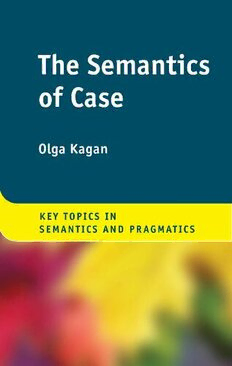Table Of ContentTheSemanticsofCase
Thephenomenonofcasehaslongbeenacentraltopicofstudyin
linguistics.Whilethemajorityoftheliteraturesofarhasbeenon
thesyntaxofcase,semanticsalsohasacrucialroletoplayinhow
case operates. This book investigates the relationship between
semanticsandcase-markinginthelanguagesoftheworld,explor-
ingarangeofphenomenainwhichcase-assignmentisaffectedby
(oraffects)meaning.Bybringingtogetherdatafromawiderangeof
languages, representing different language families, a cross-
linguistic picture emerges of the correlation between case and
meaning. Different approachesto the phenomena areconsidered,
includingbothsyntacticandsemanticanalyses,andthequestionis
raisedastowhethercasecanbetreatedasmeaningful,ultimately
helpingusshedlightonthebroaderconnectionsbetweengrammar
andmeaningand,moreover,grammarandhumancognition.
olgakaganisbasedatBen-GurionUniversityoftheNegev.Sheis
the author of the books and
KEY TOPICS IN SEMANTICS AND PRAGMATICS
‘KeyTopicsinSemanticsandPragmatics’focusesonthemaintopics
ofstudyinsemanticsandpragmaticstoday.Itconsistsofaccessibleyet
challengingaccountsofthemostimportantissues,conceptsand
phenomenatoconsiderwhenexaminingmeaninginlanguage.Some
topicshavebeenthesubjectofsemanticandpragmaticstudyformany
years,andarere-examinedinthisseriesinlightofnewdevelopmentsin
thefield;othersareissuesofgrowingimportancethathavenotsofarbeen
givenasustainedtreatment.Writtenbyleadingexpertsanddesignedto
bridgethegapbetweentextbooksandprimaryliterature,thebooksinthis
seriescaneitherbeusedoncoursesandseminars,orasone-stop,succinct
guidestoaparticulartopicforindividualstudentsandresearchers.Each
bookincludesusefulsuggestionsforfurtherreading,discussion
questions,andahelpfulglossary.
Alreadypublishedintheseries:
byAndrewGoatly
byL.DavidRitchie
byMarkJaryandMikhailKissine
byMarcinMorzycki
bySusanRothstein
byJoanaGarmendia
bySandrineZufferey,JacquesMoeschlerandAnneReboul
byOlgaKagan
Forthcomingtitles:
byHansC.Boas
byGregoryBochner
byKathrynDavidsonZaremba
byThomasGrano
byAllenHazenandJeffreyPelletier
byNicolasRuytenbeek
The Semantics of Case
OLGA KAGAN
UniversityPrintingHouse,CambridgeCB28BS,UnitedKingdom
OneLibertyPlaza,20thFloor,NewYork,NY10006,USA
477WilliamstownRoad,PortMelbourne,VIC3207,Australia
314–321,3rdFloor,Plot3,SplendorForum,JasolaDistrictCentre,
NewDelhi–110025,India
79AnsonRoad,#06–04/06,Singapore079906
CambridgeUniversityPressispartoftheUniversityofCambridge.
ItfurtherstheUniversity’smissionbydisseminatingknowledgeinthepursuitof
education,learning,andresearchatthehighestinternationallevelsofexcellence.
www.cambridge.org
Informationonthistitle:www.cambridge.org/9781108416429
DOI:10.1017/9781108236867
Thispublicationisincopyright.Subjecttostatutoryexception
andtotheprovisionsofrelevantcollectivelicensingagreements,
noreproductionofanypartmaytakeplacewithoutthewritten
permissionofCambridgeUniversityPress.
Firstpublished2020
PrintedintheUnitedKingdombyTJInternationalLtd,PadstowCornwall
Names:Kagan,Olga,1977–author.
Title:Thesemanticsofcase/OlgaKagan,BenGurionUniversityoftheNegev,Israel.
Description:Cambridge;NewYork:CambridgeUniversityPress,2020.|Series:Key
topicsinsemanticsandpragmatics|Includesbibliographicalreferencesandindex.
Identifiers:LCCN2019053941(print)|LCCN2019053942(ebook)|ISBN
9781108416429(hardback)|ISBN9781108236867(ebook)
Subjects:LCSH:Grammar,Comparativeandgeneral–Case.|Semantics.
Classification:LCCP240.6.K342020(print)|LCCP240.6(ebook)|DDC401/.43–dc23
LCrecordavailableathttps://lccn.loc.gov/2019053941
LCebookrecordavailableathttps://lccn.loc.gov/2019053942
ISBN978-1-108-41642-9Hardback
CambridgeUniversityPresshasnoresponsibilityforthepersistenceoraccuracyof
URLsforexternalorthird-partyinternetwebsitesreferredtointhispublication
anddoesnotguaranteethatanycontentonsuchwebsitesis,orwillremain,
accurateorappropriate.
Contents
ListofFigures pageix
ListofTables x
Acknowledgments xi
ListofAbbreviations xiv
1 Introduction 1
1.1 Introduction 1
1.2 WhatIsCase? 7
1.3 AbstractversusMorpho-SyntacticCase 9
1.4 CaseSystems 15
1.5 Structural,Inherent,LexicalandSemanticCase 20
1.6 Case-MarkingandThematicRoles 28
1.7 StructureoftheBook 33
FurtherReading 37
2 DativeCase 39
2.1 ThematicRoles 39
2.2 AdditionalEnvironments 44
2.3 DativeCase:Analyses 52
2.4 Conclusion 68
FurtherReading 68
3 SpatialCases 70
3.1 SpatialCases:AnIntroduction 70
3.2 SemanticsofSpatialCases 73
3.3 IllustratingRichSpatialCaseSystems:
Nakh-DaghestanianLanguages 78
3.4 Non-SpatialUsesofSpatialCases 85
3.5 Case-AssignmentinSyntax:ChallengesforaFormal
Analysis 89
3.6 InteractionofSpatialCaseandPrepositions 93
3.7 Conclusion 97
FurtherReading 98
vii
viii Contents
4 CaseandAspect 99
4.1 ObjectsinFinnicLanguages 102
4.2 AccusativeAdjuncts 120
4.3 ComplementsofPrepositions:AccusativeCase
andGoals 138
4.4 Conclusion 145
FurtherReading 145
5 DifferentialObjectMarking 147
5.1 DOMSystemsExemplified 148
5.2 TheReasoningbehindDOM? 161
5.3 VerbalInfluence:DirectorIndirect? 166
5.4 Cross-LinguisticAnalysesofDOM 170
5.5 Conclusion 187
FurtherReading 188
6 TheGenitive/AccusativeAlternationinBalto-Slavic 189
6.1 IrrealisGenitiveinBalto-Slavic 191
6.2 UnifyingGenNegandIntensionalGenitive 194
6.3 TheSemanticsofIrrealisGenitive 199
6.4 PartitiveGenitive 213
6.5 Conclusion 221
FurtherReading 222
7 PredicateCase 223
7.1 InstrumentalPredicatesinSlavic 223
7.2 UralicLanguagesandtheEssive 236
7.3 TranslativeCaseandtheNotionofChange 239
7.4 Conclusion 250
FurtherReading 250
8 GeneralizationsandConclusions 251
Terminology 257
Bibliography 263
Index 286
Figures
5.1 Relativemarkednessonthedimensions
ofanimacyanddefiniteness page173
5.2 PrioritizinginSpanish 185
5.3 PrioritizinginMongolian 186
ix

